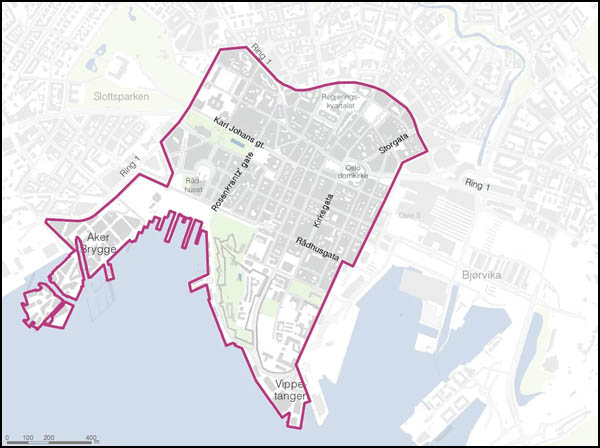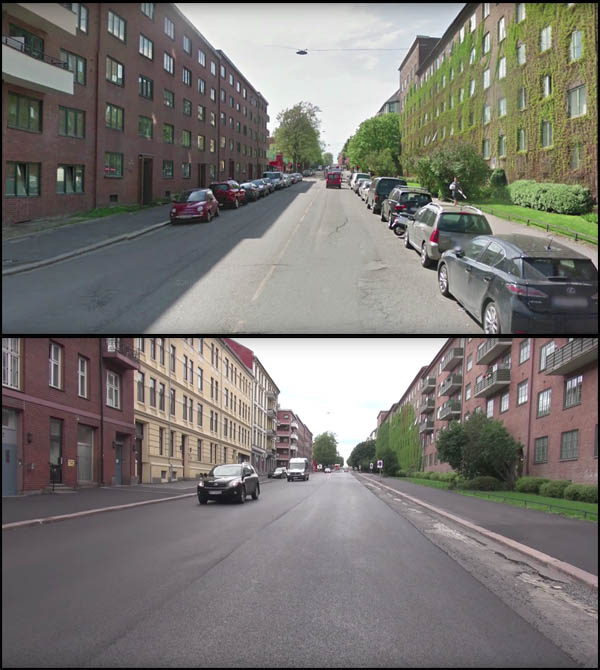Norway’s capital Oslo has for many years proclaimed its desire to tackle climate change by reducing greenhouse gas emissions. Left and right administrations alike have trumpeted their green credentials, regularly competing for the European Green Capital Award – and finally winning it for the year 2019.
The problem is, the majority of the city’s emissions emanate from the transport sector, and particularly from private cars. Road transport contributes 55% of overall emissions. Despite ambitious reduction targets, a failure to implement effective policies has meant a 15% increase between 1990 and 2016. But things are going to change:
After 8 years in office, Oslo’s conservative mayor lost the 2015 elections to a coalition of Greens and Left Socialists. This signalled a radical change in one key area of transport policy. Though the previous administration had talked a lot about green transport policies, there was a reluctance to make space for planned cycleways by removing car parking spaces. This all changed with the election of Raymond Johansen as Governing Mayor, and the Green Lan Marie Berg as Transport Commissioner. Both old and new administrations wanted to shift from car use to public transit and bicycle. But under the conservatives little was actually done before 2015 – just 3 kms of cycleways built, for example. Above all, their efforts were hampered by a perceived “lack of space” for new cycling infrastructure. But this all changed when the new régime declared one significant shift in priorities. Car parking space would no longer be sacrosanct.
The new administration immediately revised its emissions reduction targets to 50% by 2020, and carbon neutral by 2030. To achieve this, the council has introduced a Climate Budget, which will operate alongside the traditional financial budget, tracking ongoing carbon emissions. “The Climate Budget, a first of its kind plan, shows estimated emission reductions, its financing and each agency in charge.” 42 measures have been identified that directly affect the city’s emissions. Transport is central.
Initially, the administration presented a plan to ban private cars altogether from a city centre area of 1.7km², and build 60kms of new cycleways. But following opposition, primarily from local businesses, this was amended to the removal of all 650 public on-street parking spaces in the area, as well as some parking in surrounding areas deemed to be “in conflict with bike development”. Car parks in and around the central zone will stay, but many other on-street parking spaces will be freed up for alternative uses.

The programme is relatively short-term – the removal of parking spaces should be completed by the end of 2017. It is already well underway, with a number of streets undergoing the clearing of parking spaces, to be replaced by pedestrianised areas or cycleways.

Much of Oslo’s focus is on converting car use to bicycle use. Modal share is currently 8.3%, dropping to 3% in winter. But there is a lot of effort being put into building bike paths, and ensuring they are snow-free in winter. In areas around the city centre, car parking spaces are being reduced to make way for these bike paths. For example, in the district of Grünerløkka, around 185 parking spots are being removed. The aim is to reach Bremen levels of cycling – 25% – and removing on-street parking is seen as a key tool for creating space for safe cycling.
Bicycles have also replaced delivery vans in a new pilot project: started in June, a container in the Aker Brygge neighbourhood (bottom left on map) functions as a micro-terminal for freight transport. Goods are dropped at the terminal, and distributed throughout the city centre by 3 electric cargo bikes. Previously DHL used 3 vans.
We should know by 2019 whether Oslo’s strategy proves to be more successful in reducing greenhouse gas emissions than that of the previous Conservative administration.
Oslo wants to reach Bremen’s cycling modal share, 25% . In fact, through the grapevine we hear that Bremen’s cycling modal share has now declined to 23%, according to a study from the TU Dresden.
Be careful Bremen: If our transport politicians don’t wake up soon, they won’t hit their climate targets and a “Verkehrswende” will remain a distant dream.
More information about the “Oslo-Strategy” here:
Ich mag die kühle, einige sagen: karge, Art der Nordeuropäer, der Zukunft unaufgeregt und unideologisch zu begegnen und, wie seit Jahrtausenden, den Fährnissen des Klimas verantwortungsvoll zu begegnen.
Bei unserer Radtour vor 3 Jahren in Norwegen, ich sach nur: Rallarwegen, eine in seiner Transzendenz fast religiöse Naturerfahrung, sind wir zum Abschluss mit dem Zug von Bergen nach Oslo gefahren.
In Oslo begrüßt wird man von dem Großkunstwerk ‘Rear Window’ der Künstlerin Marisa Feirrera, das eine ganze Fassade des Osloer Hauptbahnhofs einnimmt. Der Name des Kunstwerks ist dem Hitchcock-Film Rear Window (Das Fenster zum Hof) entlehnt. (Der Zuschauer des Films wird von Hitchcock durch die Erzählung sowie die Kameraeinstellungen äußerst geschickt mehr und mehr in den Film hineingezogen.)
Während der Betrachtung des Kunstwerks von Marisa Feirrera verändert der (reisende) Betrachter allein durch seine eigene Bewegung die Farben und die Maße der 59 farbigen Streifen:
Die Heisenbergsche Unschärferelation, die die alte Gewissheit von ‘objektiv’ und ‘subjektiv’ zerstörte, indem sie nachwies, dass die beiden Begriffe sich unlösbar gegenseitig durchdringen, zum ‘Anfassen’.
Das Kunstwerk, bzw. die Breite der farbigen Streifen, basiert neben Heisenberg auch auf der aus der Mathematik bekannten ‘Fibonacci-Folge’ (1; 1; 2; 3; 5; 8; 13; 21; 34; 55,…), deren jeweils nächstes Glied immer aus der Summe der beiden vorherigen Glieder besteht. Je höher die Fibonacci-Zahlen, desto mehr nähert sich der Quotient zweier aufeinander folgender Fibonacci-Zahlen dem aus Kunst, Architektur und Natur bekannten ‘Goldenen Schnitt’ Φ an.
Heisenberg. Fibonacci. Kunst. Genial gemacht. In all seiner Nüchternheit ganz große publikumswirksame Kunst.
Mit der gleichen Aufgeklärtheit, mit dem gleichen, von nüchterner Analyse getragenen Schwung machen sich die Osloer an die Umorganisierung ihres Stadtverkehrs.
Wäre schön, wenn sich Hamburg, und natürlich auch Bremen, sich auf diesen Teil unserer gemeinsamen nordeuropäischen Kultur besinnen würden.
Geht doch. Der goldene Schnitt.
https://radverkehrhamburg.wordpress.com/2015/10/22/geht-doch/
“Mit der gleichen Aufgeklärtheit, mit dem gleichen, von nüchterner Analyse getragenen Schwung machen sich die Osloer an die Umorganisierung ihres Stadtverkehrs.” Ja, so ist es wohl. Aber natürlich erst, seitdem Rot-Rot-Grün die Stadt regiert. Trotzdem hast Du recht, die Ideologie “ich brauch mein Auto vor der Tür” scheint weniger bestimmend in Oslo zu sein als z.B. in Bremen und Hamburg. Und die Ängste von Verwaltung und Politik vor dem Aufruhr sind offenbar kleiner. Vielleicht gibt es dort diese Wut so nicht, die in Bremen Leuten entgegenflammt, wenn sie von einer Verringerung der Stellplätze reden. Wir haben noch viel Arbeit vor uns….
Der Kommunalwahlkampf war sehr verkehrsbezogen.
Die Osloer hatten zu entscheiden zwischen den Konzepten der Konservativen und der Links-Grünen.
Auch deshalb, wegen der vergleichsweise modernen Planungen der Konservativen, sind die Linken und Grünen mit dem Plan für autofreie Innenstadtbezirke in den Wahlkampf gezogen – und haben dafür eine Mehrheit gekriegt.
Schon die Konservativen hatten das schwedische Planungsbüro spacescape mit der Ausarbeitung einer Radverkehrsstrategie beauftragt (“Who are the cyclists? Are there differences between neighbourhoods? Between women and men? Between children and adults? “). So etwas findet man hierzulande weder bei grünen noch bei linken VerkehrspolitikerInnen.
Auszug von der Webseite von spacescape:
“Oslo, the capital of Norway, is one of the fastest growing cities in Europe, and from this fall, the municipality is aiming for the title of bike city.
Accordingly, a ”bicycle director” was hired in 2013, and since then, the municipality has been working actively with marketing, quick-fix measures, and not least, by the development of a cycling strategy.
Spacescape has been involved as a consultant in this work and began the process with a thorough examination of Oslo cyclists. We looked at such aspects as, what is the bike modeshare? Who are the cyclists? Are there differences between neighbourhoods? Between women and men? Between children and adults? To develop this knowledge we used questionnaires, cyclist observations, interviews with principals, and image surveys with different types of cyclists. This formed the foundation of the Bicycle Strategy that Spacescape has developed for the city.”
29.10.2015
http://www.spacescape.se/oslo-invests-05-bn-usd-on-bicycle-infrastructure/
Die haben also 2 Jahre lang die Radverkehrsstrategie solide ausgearbeitet (und auch schon angefangen zu malen, was auch ihr Fehler war), auf die sich rotrotgrün jetzt in Teilen auch stützt.
Aber richtig ist, die Osloer wollten mehr, als die Konservativen zu geben bereit waren.
Danke Strizzi, ich habe den Link unter den Post gesetzt. Guter Hinweis!!